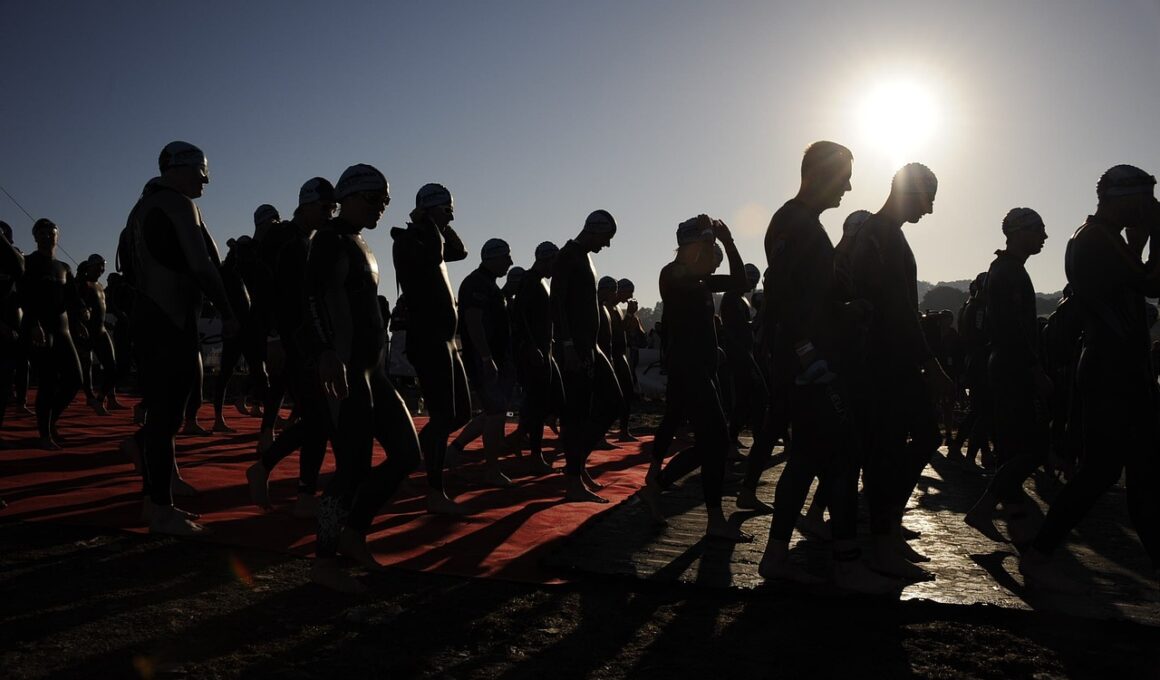How to Pace Yourself During a Half-Ironman Race
Successfully completing a Half-Ironman Race requires careful pacing strategies. It’s essential to approach this endurance event with a balanced mindset, focusing not just on speed but on maintaining consistent energy throughout the race. An effective pacing strategy incorporates training, nutrition, and recovery. Training sessions should simulate race conditions, helping you find your ideal speed across different segments. During these sessions, it’s crucial to experiment with varying speeds, allowing your body to adapt to different paces. Additionally, understand that hydration and nutrition play a significant role in maintaining your energy levels during the race. Before starting the race, ensure you’ve properly fueled your body with carbohydrates and electrolytes. Monitor your hydration strategy like using gels or drinks every 30-45 minutes. Allocate enough time for transitions to conserve energy, as this can help avoid last-minute panic. Each segment—swim, bike, run—requires its specific pacing strategy. Therefore, divide overall race time into segments to allocate appropriate energy reserves. Accurately assessing your strengths and weaknesses across each discipline will allow you to establish more accurate race strategies in advance. Finally, mental preparation is crucial for successful pacing.
Swim Segment: Finding Your Rhythm
Pacing during the swim segment is often overlooked by many athletes preparing for a Half-Ironman. The swim starts fast and can be intimidating, with the potential for adrenaline to push you out of your comfort zone. To avoid exhaustion early on, start at a comfortable pace and gradually build speed. Breathing techniques are vital in maximizing your efficiency and should be practiced during training. Establishing a rhythm allows you to settle into a trance-like state, making the swim feel easier. Use a steady, consistent stroke rather than sprinting at the beginning. Monitor your heart rate, keeping it within a manageable range. This will help in avoiding the dreaded “sprint-start fatigue.” Keep sighting to a minimum, as excessive lifting of your head can disrupt your rhythm. Use buoy markers to guide your path instead. Offsetting your legs can improve your streamlining. In this segment, aim to conserve energy while maximizing speed, transitioning into the bike segment feeling invigorated. Upon exiting the water, focused breathing will help regain control of your heart rate as you prepare for the next segment.
In the bike segment, proper pacing is key to achieving an optimal race outcome. It’s crucial to strike a balance between maintaining a strong effort and preserving energy for the run. To assist in determining your ideal pace, regularly monitor your heart rate or power output. It’s beneficial to perform long rides during training to simulate race conditions, allowing you to gauge your ability to handle sustained efforts. During the race, focus on a consistent cadence that feels sustainable. Gradually build this pace, increasing slightly as you settle in. Keep an eye on your nutrition by incorporating energy gels or bars, as maintaining optimal carb intake will be vital. Hydrating consistently will also set you up for post-bike performance. A common mistake is to push too hard on the bike, leading to exhaustion during the run. Therefore, assess your perceived exertion levels and ensure you remain within a comfortable range. The goal in this segment is to ride confidently while leaving enough reserves for the forthcoming run. Aim to maintain an even split throughout; this strategy will enhance your transition into running more smoothly.
The Importance of Transitions
Transitional phases are often the most underestimated parts of a Half-Ironman. Proper pacing during transitions can greatly improve your overall race time. Planning your transitions diligently can save precious seconds. Take the time to practice transitions during training, so they become second nature during the race. Organize your gear efficiently—this saves time both during T1 and T2. Have everything arranged logically, ensuring you know exactly where to find your running shoes and nutrition. Minimizing the time spent in transitions means less time off your feet, so set up a well-ordered system for quickly changing gear. Before the race, visualize your transitions, walking through each step in your mind. Think about how to approach each aspect: removing your wetsuit, putting on your helmet, and grabbing your bike. Consider performance-enhancing strategies, such as practicing barefoot kite running to improve your speed. Allocate time in your pacing plan for these transitions, understanding that they are part of the race. Approach them with the same mental clarity you’d apply to actual race segments to stay focused, maintaining control over your pace during these crucial moments.
When tackling the final running segment, maintaining your pace is crucial. After biking hard, many athletes encounter fatigue during this leg of the race. It’s essential to start the run slowly, allowing your legs to adapt to the new motion. Watching your heart rate while running keeps you from going out too fast. Focus on keeping a sustainable pace rather than sprinting out of the gates. Assess your running form, ensuring strides are efficient and fluid. Incorporating short walk breaks can help ease fatigue as well. Hydration remains critical in this segment; consume fluids strategically to avoid cramping or dehydration. Remember to utilize your nutrition strategy from the bike. Gels, sports drinks, or chews can power you through the race. Regularly check in with yourself and adjust your plan based on your energy levels. A negative split strategy can enhance your ending time; try to finish strong, gradually increasing speed as race energy builds. Setting small milestones throughout the run helps break down the distance mentally. Staying mentally strong can mean the difference between maintaining effective pacing throughout this critical final segment.
Post-Race Recovery and Reflection
After crossing the finish line of a Half-Ironman, your pacing strategy is not over yet; recovery plays a crucial role in maintaining performance and preventing injuries. Beginning immediately, hydrate thoroughly to replenish lost fluids during the race. Gradual stretching is important to aid circulation and muscle recovery. Plan post-race meals that are rich in protein and carbohydrates to rebuild muscle while also restoring glycogen levels. Reviewing your pacing strategy is beneficial for future events; note what worked well and what needs adjustments. You might want to keep a race log to identify strengths and weaknesses through each segment. Ask yourself if your pacing allowed you to finish strong or if you experienced fatigue sooner than expected. Communicate with fellow athletes about their pacing strategies and observations; this can yield invaluable insights. Engaging in a proper cooldown routine may include light jogging or walking to lower heart rates gradually. Reflecting on your pacing will prepare your mind for upcoming races, improving your overall performance. Ultimately, pacing yourself in a Half-Ironman Race sets the groundwork for achieving your best personal results.
In conclusion, effective pacing strategies are fundamental to succeeding in a Half-Ironman. Understanding the nuances of pacing during each segment can lead to a remarkable performance. You must balance pushing limits while preserving enough energy for all portions of the race. Develop and fine-tune nutrition and hydration plans ahead of time; using these plans helps sustain you throughout. Each race is an opportunity to learn, allowing you to adapt and improve pacing strategies for future events. Recognize the significance of mental preparation; pre-visualizing each segment assists in achieving your pacing goals effectively. As you train, practice under various conditions to build endurance and experience, allowing flexibility in your race approach. Use various biking techniques to aid recovery and enhance run performances. Each runner will have different pacing sweet spots; therefore, assess your unique limits. Things will never go fully to plan, but having a strategy offers a framework for success. Commitment to pacing methods allows you to not just finish but to thrive in every event you undertake, gradually improving towards your ultimate goals in the sport.
Pacing Strategies: Key to Performance
Effective pacing is what makes or breaks your race. Understanding the importance of pacing techniques during your prep work will set the stage for success as you embark on the journey of a Half-Ironman. Proper pacing involves managing your energy, hydration, and mental toughness throughout the race. Before the event, develop a racing strategy that includes expected finish times for each segment and the overall race. Analyze your training data using methods like heart rate variability or perceived exertion levels to help calibrate your pacing strategy. Aim to remain consistent across all three disciplines while leaving energy for the final run. It’s also important to match your pacing strategy with the weather conditions on race day. Consider that hot temperatures will demand more from your body, requiring a more conservative pacing approach. In addition, study the course profile so you can anticipate where to push harder and where to save energy. Conservative pacing should ultimately lead to a stronger finish while allowing you to enjoy the race experience. Engage with other athletes and share your thoughts on the importance of pacing, which can provide valuable insights for your performance.


